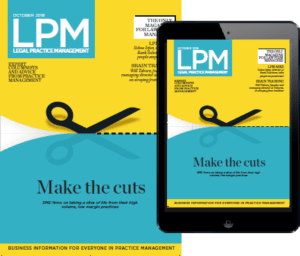
Change is always around the corner
Mike Stevenson, managing director at Iceberg, discusses unforeseen disruptions and strategies for law firm to mitigate their financial impact.
When last month I wrote of how legal firms should always have plans in place for the unexpected, I did not think we’d have seen two such dramatic examples of why such preparation was necessary.
Though last month it was court rooms closed due to failing infrastructure that was of a concern to some, the challenge soon moved to something much more fundamental.
While industrial action by the Criminal Bar Association (CBA) was anticipated, the scale and length of any strike will always be an open question. Depending on those around the negotiating table, it may be days, weeks, or months.
Financial planning for delays in invoice payments are one thing, and part of any legal firm’s working lives, but the risk of whole cases potentially being cancelled, and with no certainty on when things may return to normal, is another thing.
The need then for having contingency plans in place is apparent and part of a sensible approach to business. After all, the financial obligations of legal firms have not been suspended, even if cashflow and liquidity are disrupted.
It may be necessary that a firm seeks support across over a year or more, but with the right support this can be a manageable and effective measure of ensuring operations can continue and seeing the sector through present challenges.
On top of this sector-specific challenge is the impact of the sad death of Her Majesty Queen Elizabeth II. With a moment of great historical importance, and period of national mourning, comes inevitable change to working practices.
An unexpected bank holiday to concur with Her Majesty’s funeral, and businesses choosing to adopt changes to working patterns in response to the events, created a period of unexpected flux. Invoices may have been further delayed, meetings postponed, and delays may have occurred in the system.
Coupled with the impact of inflation, interest rate rises, and energy prices, these unexpected challenges may present unexpected gaps in financing – but payroll, rent and infrastructure costs still need paying.
Supporting successful, well-managed firms who find themselves in this position is central to Iceberg’s purpose. We understand these challenges occur and the impact that they may bring, and our knowledge of the sector enables us to present firms with options suitable for their circumstances.
The specific combination of disruptions over the last months is unique but the fact that disruption exists, and will continue to do so, is an almost absolute certainty.
What almost felt like an absolute certainty was that interest rates were not going to change. After year after year of no change at all, or minor fluctuations, 2022 has seen a period of unpheaval unseen in well over a decade.Where financial planning for low, unchanging interest rates had almost become second nature, change seems to be the new order.
Firms throughout the sector will be considering the impact of further rises, which are anticipated to reach 4% in the second quarter of 2023 – and, if they were to occur, would mean a rise of over 3% in twelve months.
Though the most lasting impact of this period of change for the sector may well be the re-emergence of KCs in court rooms, after some 70 years of QCs, it will be the decisions that firms make about financial management that will be of most immediate importance.
With sound planning, the legal sector will once again overcome the challenges it may face – and I look forward to supporting them in doing so.

Prepare for the unexpected – a well-worn phrase, and for good reason
Unforeseeable events and costs can, and do, arise that will put immediate pressure on even the most prudent financial plans, says Mike Stevenson, managing director at Iceberg.
A situation recently sprung up in Manchester when the Crown Court was suddenly forced to close so the building could be tested for asbestos. What was expected to be a five-day closure soon became two weeks of delayed or reorganised cases.
Not even the most assiduous firm would plan for such a specific eventuality, but it could still impact a firm’s business schedule and may well push back payments from clients. Suddenly, and out of nowhere, a well-managed firm may have a cash flow shortfall through no fault of its own.
That the unexpected closure of Manchester Crown Court follows soon after Bolton Crown Court had to adjourn due to the risk of new lights falling down speaks to the uncertain environment in which law firms today operate!
It isn’t though just the unpredictable, knock-on effects of crumbling building infrastructure that can impact a firm’s balance sheet, or even just negative news.
A firm experiencing sudden growth in its client base may need to expand its team, and with a growing team comes the potential costs of acquiring Practising Certificates.
Also, rather than simply wishing to expand its existing team, a firm unexpectedly could be presented with the option of acquiring another. A great opportunity that they may not wish to miss, and one for which there financing options available.
These are both positive developments that may have been unforeseen six months before they became a reality, and firms may wish to seek financial support to ensure that they are able to make the most of these unexpected opportunities.
Firms seeking such support can take comfort in how common a practice it is to seek financial support, whether it be over a period of months or years. What may seem to some as a sign of failure to be prepared is in fact simply an entirely routine feature of sound operations.
In many cases the risk lies in not taking the opportunity and support available, not in the sudden financial shortfall itself – and firms should be prepared to explore the options available to them.
As we head towards autumn there is also another event for which we couldn’t have prepared – a new government led by a new prime minister. Both candidates, Liz Truss and Rishi Sunak, are expected to reform the tax system. The candidates also speak of cutting further redtape, which may not only impact law firms but also their client’s operations.
Both such changes may come with a sudden increase in demand for legal advice to help understand the new regulatory environment, as well as the need for law firms themselves to seek advice on their own financial operations.
Rather than preparing for the unexpected, perhaps it would be better to simply to expect change and accept it will happen. Firms that are aware of the financial support and options available to them, and have them at hand, are taking sensible steps and doing what they can to be ready for the inevitable.
Most Popular

Where are the challenges for SME law firm leadership changing?

The leading annual picture of SME law firms' changing strategic priorities

Law firms undertaking identity verification checks must register as an ASCP

Robust onboarding processes are fundamental to effective risk prevention
TA Triumph-Adler provides tailored support to meet compliance requirements

Osprey Approach's webinar explores the benefits of a digital-first approach

Distinguishing cyclical trends from immediate threats
Financial planning is critical, but not every development in the legal market, and the economy as a whole, merits a response from law firms, says Mike Stevenson, managing director at Iceberg.
The Bank of England is predicting a further increase in energy prices and, as it continues to try and get a grip of inflation, is soon expected to make the sharpest rise in interest rates in thirty years. When it comes to planning, it is such immediate and near-term concerns that can often dominate our thinking – but law firms cannot simply be concerned about the present, they must take the big picture into consideration.
Let’s look at a recent example – after months of concern over the UK economy, with many predicting an unhindered slide towards recession, the news that GDP rose by 0.5% in May caught most economists off guard. Lurking underneath that positive data though was the news that turnover for the legal services had fallen by 16%, from April’s £3.92 billion to £3.28 billion the following month.
At first glance this is would appear to be a deeply worrying contraction and cause for alarm, but digging deeper into the data shows a different story. In May 2021, the sector recorded a turnover of £2.93 billion, down from £3.74 billion in April 2021 – a fall of 22%. When considering the 2022 figures, it appears that rather than an alarming fall the data points to a cyclical trend tied to the end of financial years.
Viewed together and put into context, May’s decline in turnover and GDP rise show a markedly contrasting situation to what initially appeared to be the case – a healthy legal sector and an economy with warning signs still flashing overhead.
The UK economy still faces the same challenges it was facing in March and April, and one good month of economic activity does not itself tell you much about its overall health. It will take two or three more months until we can assess whether the slide to recession has been stopped.
The same is true of the legal sector. May’s figures were a shocking snapshot, but it was only a snapshot. By looking at the bigger picture we can see the long-term trend and place those figures in context. Legal firms looking to plan for their financial futures need to consider the big picture. Posting positive and profitable half-year results does not mean that cash flows will remain evenly spread across the rest of the year.
Healthy law firms, like the economy itself, will fluctuate. As May’s turnover figure shows, there will be months when sensible, planned financing can allow operations to continue smoothly and without concern – and it is not too early to start considering plans for May 2023.
That the economy can change rapidly, and that unforeseeable events such as Covid can alter the entire landscape, is a fact of life – but planning remains as vital as ever. For those firms currently planning their future finances, remember to look at the big picture. Understand which events are cyclical and ensure you have the right support in place so that when major shocks do hit the economy that you are still able to access the financing necessary to continue business as usual.
Most Popular

Where are the challenges for SME law firm leadership changing?

The leading annual picture of SME law firms' changing strategic priorities

Law firms undertaking identity verification checks must register as an ASCP

Robust onboarding processes are fundamental to effective risk prevention
TA Triumph-Adler provides tailored support to meet compliance requirements

Osprey Approach's webinar explores the benefits of a digital-first approach

Boom no bust – avoiding complacency after a period of high revenues
The pandemic might have been lucrative for legal businesses, but inflation and the consequent squeeze on cash could catch them off guard – says Mike Stevenson, managing director at Iceberg.
Did you have a good pandemic? This may sound like a flippant question but new research suggests that for many in the sector it was a time of increased revenue and lower costs.
Conducted by Evelyn Partners, the research found that revenue for the top 50 law firms grew by 4.2% during 2020-2021, thanks to clients seeking advice on how to adapt to new regulations. Alongside this revenue growth, the cost of doing business fell. With offices mothballed and travel expenses side-lined, technology and flexible working practices were enabling firms to meet the increased demand of clients.
These unique circumstances led to the overall revenue of those top 50 firms for the first time topping £20bn.
But these changes mask a series of challenges now facing the sector as a whole.
The Evelyn Partners research also found that while revenue rose so did pay roll costs – with an increase of 4.8%, and an expectation that the next pay round will push this higher as firms compete for staff. Investment plans that were put on hold during the pandemic are now being dusted down, but inflation is starting to bite and will start to erode the cash reserves acquired through revenue growth.
For small and medium size firms, inflation is also presenting a new array of challenges.As clients start to feel the pinch in their own cash flows, payments may be delayed with inevitable knock-on effects to those of their legal firms – which will also now be subject to the same pressures.
Firms that saw strong revenue levels during the pandemic may now find themselves in need of VAT finance support to avoid HMRC penalties, or to investigate flexible payment options for practice finance funding.
Most Popular

Where are the challenges for SME law firm leadership changing?

The leading annual picture of SME law firms' changing strategic priorities

Law firms undertaking identity verification checks must register as an ASCP

Robust onboarding processes are fundamental to effective risk prevention
TA Triumph-Adler provides tailored support to meet compliance requirements

Osprey Approach's webinar explores the benefits of a digital-first approach

Consolidation as a means to succession success
Consolidation is an increasingly popular solution to the well-entrenched succession problems in SME legal – Mike Stevenson, managing director at Iceberg, explores the details of this approach.
The legal profession has an age issue. According to the Solicitors Regulation Authority (SRA), over one in five – or 22% – of partners are aged between 55 and 64, with 13% of those in one-partner firms over the age of 65.
Merger and acquisition (M&A) activity has been a theme in a legal market ripe for consolidation at the top end for a number of years, but it is in smaller end of the market – the one-or-two partner firms in provincial towns – where we see the greater numbers of mergers.
There are hundreds of law firms that operate a ‘monarch system’ in the UK. This is typically where there is one partner, who has usually founded the firm, is the lead generator of business, and has clear seniority over all the others.
This may suit the firm’s other lawyers because they earn more under this system than they would if relying only on the work they bring in themselves. However, the structure presents an issue for the ‘monarch’ in this firm if they wish to retire.
Retiring partners can chose to attempt to find a successor or close the business. Another, increasingly popular option, is merging with a local or complementary firm.
For the firm leading the merger, this presents a number of benefits. It can open up opportunities for new clients and sectors, or simply give the business greater economies of scale and a larger presence in the market. In a sector where recruitment is increasingly difficult, it also provides the firm with fresh blood and new ideas.
M&A addresses a number of issues for the retiring partner too – mainly, any ongoing work they have can be picked up seamlessly, which is particularly important if they have long-standing clients who rely on their expertise. Secondly, it adds a layer of protection for retiring partners against historical claims or personal guarantees.
Under current rules, retiring partners can be subject to negligence claims against them – or their estate – for six years post their retirement date. Most partners will purchase professional indemnity cover for this period. However, the Solicitors Indemnity Fund – dubbed a safety net against claims beyond this period – will close in September next year, leaving partners who choose to close their practice exposed. With the Law Society estimating that 11% of claims are made outside of the SRA’s mandatory run-off period, that leaves the retiring partner facing an element of risk.
Merging with a firm transfers that risk to the firm and not the individual, leaving the partner to enjoy their retirement years without that risk of a claim landing on their doormat. The only caveat to this is that even where there is an indemnity, that protection is only as good as the financial situation of the person providing it.
It is also likely that the partner would be released from any personal guarantees in a merged firm. Again, the caveat in this case is that the party required to release you may need to ensure that they are left with sufficient protection from the remaining partners before agreeing to the release.
The challenge for retiring partners is to find the right firm with which to merge and how the merger can be financed. Typically, we don’t see large sums changing hand for smaller legal practices – the greater issue is securing working capital to ensure a successful merger.
We have seen an increase after the pandemic in enquiries for working capital solutions for merging firms and we have supported a number of clients with funding arrangements. We expect this to accelerate in the coming years as the ‘baby boomer’ generation seeks a way out and to pass the baton onto younger solicitors and legal firms.
Most Popular

Where are the challenges for SME law firm leadership changing?

The leading annual picture of SME law firms' changing strategic priorities

Law firms undertaking identity verification checks must register as an ASCP

Robust onboarding processes are fundamental to effective risk prevention
TA Triumph-Adler provides tailored support to meet compliance requirements

Osprey Approach's webinar explores the benefits of a digital-first approach

Cash is reality when it comes to law firm success
Does the post-pandemic economy spell more cash flow for law firms? Mike Stevenson, managing director at Iceberg, highlights potentially persistent constraints, and how businesses can cope.
The masks have come off, the plastic barriers separating restaurant tables have come down and we can now go to the pub without the need to order a scotch egg. After two years of Covid-19, life for many is returning to some form of normality.
For legal businesses, that signals a renewed focus on careful cashflow management. While the sector was not exactly awash with cash during the pandemic, a combination of government lending schemes providing cheap debt, furlough and and a softening of requirements for partners’ tax payments certainly helped liquidity.
At Iceberg, we have seen a recent increase in the number of enquiries relating to borrowing requirements linked to cashflow management as normal market conditions return. As the old saying goes – ‘cash is reality’.
Cashflow issues have historically been a significant contributory factor in law firm failures. As profits are distributed to partners, and it is more tax efficient not to hold capital within the business, most law firms operate with a low level of cash.
Law firms’ main costs centre on rent, salaries and professional indemnity insurance (PII), all of which must be paid on a monthly or quarterly basis.
Other liquidity challenges relate to the nature of legal work. Lock-up, the combination of unbilled work in progress and outstanding accounts, is a drain on working capital. According to various studies, law firms average between 110-140 days’ worth of earnings sitting in lock-up.
It’s an issue that many law firms wrestle with on a monthly basis and cashflow issues can impact smaller firms in particular as they do not necessarily have the breadth of resource to call upon.
There are some simple steps that businesses can take to more effectively manage cashflow.
Plan, plan and plan again
Being fully aware of cashflow bumps in the road is the most effective way to mitigate and plan for issues. We advise clients to prepare a cashflow forecast for a minimum of 12 months ahead to assess where cashflow issues are likely to occur. We also advocate the use of a rolling, three-month forecast for more accurate micro-management of cashflow.
Ensure adequate funding
Law firms have many funding options open to them to cover cashflow and other costs, such as overdrafts, bank loans and specialist legal sector funders such as Iceberg.
One specific area to consider is the time to pay arrangements with HM Revenue & Customs (HMRC) for your deferred VAT liabilities. Meeting the cost of VAT each quarter – particularly when payment relates, in part, to unpaid fee notes – can put a real strain on cashflow.
A VAT loan account is an option that enables the law firm to spread the cost over three monthly payments. This type of facility can be taken out to supplement other types of borrowing, and payments can be made directly to HMRC from the lender on the law firm’s behalf.
Keep a close eye on lock-up
Billing discipline and hygiene is central to healthy cashflow management. It is recommended that firms bill on at least a monthly, or sometimes weekly, basis, where possible. Firms should also make sure they bill before the month end as this increases the chances of being included in an early pay-run, boosting cashflow.
The number of lock-up days should be considered a key performance indicator of any legal firm.
Overhead discipline
At a time of rising costs – from salaries to energy – it’s important that law firms maintain overhead discipline. Annual audits of all costs should weed out those overheads that aren’t important to the business.
One of the biggest costs for legal firms is rent and, with the move to hybrid working, firms should consider whether their premises are the right size for the modern workplace. Can costs be saved through more remote working or shared office space, for example?
A PwC report from last year found that 48% of the top 100 law firms plan to reduce their office footprint in the short-to-medium term and I’m sure that is a trend that will be repeated across the country.
Most Popular

Where are the challenges for SME law firm leadership changing?

The leading annual picture of SME law firms' changing strategic priorities

Law firms undertaking identity verification checks must register as an ASCP

Robust onboarding processes are fundamental to effective risk prevention
TA Triumph-Adler provides tailored support to meet compliance requirements

Osprey Approach's webinar explores the benefits of a digital-first approach

Preparing effectively for PII renewals can save time and cost
As we enter March, many in the industry will be planning for their professional indemnity insurance (PII) renewals. Iceberg’s managing director Mike Stevenson offers some tips.
Changes implemented by the Solicitors Regulation Authority/Law Society in 2015 enabled law firms to purchase PII at any time of the year, which has simply created another renewal window. Previously, firms had to secure their PII by 1 October each year, but insurers responded by offering 18-month policies, creating a new window on 1 April.
An estimated 30% of the market now renew their policies on the 1 April deadline and the good news is that premiums have stabilised this year, and in some cases reduced, as the impact of Covid abates and its consequences on claims have become more apparent.
It is also rumoured that new insurers are contemplating coming into the market which, along with additional capacity, could put a downward pressure on prices.
However, with general inflationary pressures hitting all businesses, law firms need to ensure they keep a firm grip on costs where they can. There are a few steps law firms can take to make the process of renewal as smooth as possible.
PII renewal best practice
Firstly, planning is key. In order to secure the right quote from an insurer, legal businesses need to ensure that they thoroughly prepare and provide as much information as they can to their chosen broker. This will help ensure that the insurance underwriter has all the information required to evaluate the risks involved. We would advise firms start the process as soon as possible to allow plenty of time for collating the necessary information and so they can be as thorough as possible in their planning.
It’s also important to explain how your business has responded to the pandemic and what measures and processes were implemented to adapt during lockdown. Underwriters will want to understand whether those processes are fit for purpose for long-term homeworking and will want to include more nuanced elements, such as quality control around complex work.
Finally, it’s important to include your report and accounts in the original submission. Take the time to provide context around this, including explaining any bad debts and highlighting any cash reserves. You will need to show insurers what is being done to ensure the financial stability of the firm, and provide evidence that you are forward-looking.
Industry challenges
In terms of managing the costs of PII, firms can consider financing options, some of which are specifically designed to help law firms meet the cost of PII premiums by spreading payments over the period of cover.
With most firms choosing to pay their premiums monthly, rather than in a single payment, and most insurers earning commission from the vendor finance option they present with the policy, law firms are paying more than they should in finance costs.
Utilising a PII loan facility enables law firms to spread their premium costs while paying less interest. By comparison with the PI broker vendor finance options, lenders typically offer firms greater flexibility of payment, allowing them to defer the first repayment by one month and spreading the premium costs over 12 monthly payments.
Law firms should consider all financing options when renewing PII and not just opt for the vendor finance option.
Most Popular

Where are the challenges for SME law firm leadership changing?

The leading annual picture of SME law firms' changing strategic priorities

Law firms undertaking identity verification checks must register as an ASCP

Robust onboarding processes are fundamental to effective risk prevention
TA Triumph-Adler provides tailored support to meet compliance requirements

Osprey Approach's webinar explores the benefits of a digital-first approach

How can legal firms plan for partners’ and members’ tax season?
Partners’ and members’ tax season is upon us, and for many partnerships, this can be a bit of a minefield. Mike Stevenson, managing director at Iceberg, highlights some things to keep in mind.
Partners and members in firms are taxed based on their individual share of the partnerships’ profits for the tax year. This is pretty similar to how the self-employed pay tax – that is, each partner is billed as if they are a self-employed business. As profit in partnerships can be divided in any way that partners see fit, each partner will have a specific percentage of profit income assigned to them.
The way partners’ tax works means that tax and national insurance isn’t taxed from earnings at source and will instead be billed in the future. This nuance calls for careful planning, as partners’ and members’ tax can amount to a hefty bill to be paid in January – at a time of low client billing activity following the festive period, and a resultantly restricted cash flow.
So how can firms plan for tax season effectively to ensure a smooth process and minimum impact?
-
Understand what deadlines you’re working to
The deadline for partners to file their tax return is the same as the self assessment deadline – midnight on 31 January for digital submissions, and 31 October (three months earlier) for paper returns.
Missing the submission date is punishable with an immediate £100 fine, with additional charges applied for further delays. These can accumulate to become a significant fine, so it’s important to be aware of the deadline you’re working to and plan accordingly. There has been a little leeway given by HMRC this year, but do be careful not to think this is a carte blanche to be late filing the returns.
-
Be aware of any complications or exemptions
Certain circumstances have slightly different rules when it comes to paying partners’ tax. For example, in the opening year of a partnership, the tax needs to be paid between the start date of the partnership and the end of the tax year.
Limited liability partnerships (LLPs) also have their own set of rules when it comes to paying tax, with salaried partners being taxed as employees if certain criteria can be met.
It’s important to be aware of potential exemptions, changes or complications when it comes to planning for partners’ tax so you don’t get caught out when filing your submission.
-
Planning, planning, planning
There is no doubt that the pandemic has created cash flow challenges for many firms. While a number of firms will have taken out loans and made the most of government backed schemes in order to ensure high liquidity during challenging times, many will now be commencing repayments.
Partners’ and members’ tax bills will be coming at a time of high outgoings for many partnerships, which is why it’s key to plan in advance how the tax will be paid, whether financing solutions are needed, and – if so – what options are out there?
-
Look at bespoke financing solutions
There’s a range of options available if you need to finance your partners’ and members’ tax, including bespoke funding solutions that are designed specifically for this purpose. An example of this is an income tax loan, which offers a flexible way to spread the payment of your income tax liability.
There are numerous benefits to this, including flexible funding options, additional credit facilities, and the fact many funders, such as Iceberg, will make the payments directly to HMRC on behalf of a firm’s partners.
Most Popular

Where are the challenges for SME law firm leadership changing?

The leading annual picture of SME law firms' changing strategic priorities

Law firms undertaking identity verification checks must register as an ASCP

Robust onboarding processes are fundamental to effective risk prevention
TA Triumph-Adler provides tailored support to meet compliance requirements

Osprey Approach's webinar explores the benefits of a digital-first approach

What can law firms do to start 2022 on a strong financial footing?
Iceberg’s Mike Stevenson talks liquidity, savings, reflection, resilience and talent attraction – themes that will likely define the new year for law firms.
In a recent report, NatWest revealed that law firms’ bank balances at the end of 2020 were substantially higher than they were the year before. A wide range of factors were named that impacted this, from unused borrowing from government schemes and use of the furlough scheme, to the use of VAT deferrals schemes and the reduction of partner drawings and dividends.
While this would have been an advantageous position at the end of last year, many law firms are facing a very different year next year, with scheme repayments starting and deferred tax needing to be paid. The end of the furlough scheme in September also means that legal businesses will have lost a key resource that supported them in managing costs.
There are a range of measures law firms can adopt as we look to the new year, to ensure that they are equipped to manage all eventualities.
Building resilience through liquidity
As we look to 2022, one key focus for law firms should be building resilience.
Maintaining high levels of liquidity is a key part of this, which might be a challenge considering that firms will be facing much higher costs than those incurred throughout the pandemic.
In order to navigate this, it’s important for law firms to consider how they use credit and loan capabilities. Firms should borrow short to pay short – leaving long-term Coronavirus Business Interruption Loan Scheme (CBILS) or Bounce Back Loan Scheme (BBLS) cash in the bank to build long-term stability and resilience. When it comes to financing shorter-term liabilities, firms can look at shorter-term borrowing options that are tailored to those specific needs.
Learning and applying the lessons from the pandemic
The pandemic would have been a steep learning curve in cost-saving and it’s time for legal firms to apply the lessons learned.
Perhaps firms have explored moving to smaller premises, implemented long-term flexible working models, or streamlined processes to boost productivity. It’s time to do an audit of what processes have worked, and which ones you want to implement permanently.
Equally, it’s also key to look at processes and changes that might not have yielded the required results and to implement change if something isn’t working.
Future proofing by looking forward
It’s also really important for legal businesses to be forward looking and plan for some of the challenges that they might encounter in the year ahead and beyond.
Talent management is an example of an industry issue that firms can plan for. Ensuring adequate financial incentives, training platforms and a clear promotion structure is a great way to attract talent, as is shining a focus on culture and wellbeing.
Most Popular

Where are the challenges for SME law firm leadership changing?

The leading annual picture of SME law firms' changing strategic priorities

Law firms undertaking identity verification checks must register as an ASCP

Robust onboarding processes are fundamental to effective risk prevention
TA Triumph-Adler provides tailored support to meet compliance requirements

Osprey Approach's webinar explores the benefits of a digital-first approach

The cost of Professional Indemnity Insurance is higher than ever – how can legal firms deal with it?
The rising cost of Professional Indemnity Insurance is a major threat to SME law firms’ futures, but there are a few things they can do about it, says Mike Stevenson at Iceberg.
One of the most significant costs faced by legal firms at the moment is Professional Indemnity Insurance (PII), with most firms seeing it rise steadily over the last few years. Premiums have increased as much as 50% year-on-year and it’s unclear when this trend will start to taper off.
Indeed, a recent report by broker firm Lockton revealed that the outlook was ‘bleak’ for legal firms when it comes to the cost of PII, with an average increase in premiums of 27.3% reported last year.
A few factors have driven this upward trend – the premiums in recent years have not been enough to pay for all the claims insurers have settled. And it’s not simply the number of claims that’s rocketed – the value of those claims has also increased. As a result, insurers are preparing themselves for a barrage of claims, and this is driving the market’s upward trajectory.
Tips when applying for PII
There are a number of considerations underwriters take into account when quoting premiums for PII, and the Covid-19 pandemic has created a range of additional factors, with the furloughing of staff likely to be considered, as well as challenges created by remote working and other disruptions to business.
With higher premiums likely, many firms won’t hunt for the most suitable policy when it comes time to renew their PII. Our first piece of advice would be to take the time to find the most competitive deal you can – in a highly price-driven market, this will make a lot of difference.
It’s also important to remember that an underwriter is assessing the professionalism, credibility and long-term stability of your business when assessing your application for insurance, so it’s vital that the proposal reflects this. Take the time to collate and include detailed information about your firm. Think carefully about any proactive risk-mitigation steps you’ve applied since your last renewal or any actions you’ve implemented to improve processes.
We, of course, know that the pandemic created numerous challenges for the legal sector, but if you were able to respond to those with some proactive steps, you should include details of this in your proposal. Any positive changes that led to enhanced productivity, quality control, or aided cashflow, should be documented in detail.
PII and cashflow is a concern for legal SMEs
One of the biggest challenges associated with soaring premiums is the impact it’s having on firms’ cashflows, with many still focusing on building financial reserves as they continue to plan for their post-pandemic recovery.
As part of this, legal businesses will be looking at financing their PII. Being able to pay your PII in monthly instalments will make a difference at a time where it’s still hard to predict where the economy, and the industry, will be at in six months.
Business owners need to consider that vendor finance options can be a lot more expensive than external alternatives. A little extra research into independent providers will go a long way in ensuring you secure funding that’s flexible, straightforward, and tailored to your needs.
Most Popular

Where are the challenges for SME law firm leadership changing?

The leading annual picture of SME law firms' changing strategic priorities

Law firms undertaking identity verification checks must register as an ASCP

Robust onboarding processes are fundamental to effective risk prevention
TA Triumph-Adler provides tailored support to meet compliance requirements

Osprey Approach's webinar explores the benefits of a digital-first approach




